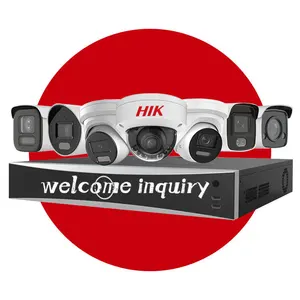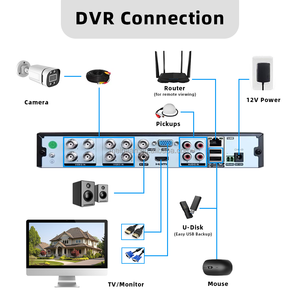(40923 products available)









































































































































































































Bullet cameras offer a cost-effective and reliable surveillance solution that is widely used in commercial and residential settings. Wholesale bullet cameras can be customized to suit specific requirements. Based on features and specifications, bullet security cameras can be classified into four main types.
Analog Bullet Cameras
These were the first types of bullet cameras to be manufactured. They work with a network video recorder (NVR). They transmit analog signals to the DVR through coaxial cables. Analog cameras have a resolution of 720p or 1080p. Unlike digital cameras, they do not require a lot of bandwidth to function. Bullet analog cameras are more affordable compared to digital surveillance cameras. They are easy to operate, install, and maintain. However, their video quality is not as excellent as that of newer models.
HD Bullet Cameras
The introduction of high-definition (HD) cameras in the market brought significant advancement in surveillance technology. HD cameras have a better resolution of up to 1080p or 4mp compared to analog models. The clarity of recorded footage is impressive. Analog cables still transmit signals to the DVR, making installation easy. These cameras give business owners more options when choosing affordable surveillance cameras.
IP Bullet Cameras
Internet protocol (IP) bullet cameras are an improved model of HD cameras. They have greater resolution because they capture and compress images with a higher megapixel count. Depending on the model, IP bullet cameras can have a resolution of 1080p, 4mp, 5mp, 12mp, 20mp., or beyond. These cameras also provide better edge-to-edge clarity than their HD counterparts. They enhance physical security with features like motion detection, remote viewing, video analysis, and alarm systems. IP cameras offer crisp and clean video footage that helps identify criminals. These cameras need a lot of bandwidth to operate efficiently, which can increase the operational costs of a business. They have network video recorders (NVR).
Thermal Bullet Cameras
When excellent night vision surveillance is required, thermal cameras are the best option. They provide clear visibility in total darkness, which helps security personnel monitor large outdoor areas. Thermal cameras detect heat emitted from objects and create an image based on temperature variations. Their sensitivity is very high. Bullet infrared cameras with thermal detection at night can help spot potential intruders from miles away. Combining visible light and thermal imaging produces high-quality surveillance footage both day and night.
Bullet security cameras have several features that customers can modify to suit their needs. They may include the following features:
Due to their versatility and compact size, bullet cameras are used in various surveillance applications, including;
Perimeter Security and Outdoor Surveillance
Bullet cameras are well-suited for monitoring large outdoor areas, such as parking lots, building perimeters, and parks. With their ability to keep an eye on the surroundings, bullet cameras can provide comprehensive surveillance coverage to enhance perimeter security and outdoor monitoring. Bullet surveillance cameras can offer enhanced perimeter security by monitoring the surroundings in real time and deterring potential intruders or unauthorized access to sensitive areas. Depending on the specific model and features, bullet cameras can also monitor outdoor environments under challenging conditions, such as low-light situations, harsh weather, and even high-risk areas like industrial sites or critical infrastructure, ensuring reliable surveillance in various circumstances.
Monitoring High Traffic Areas
Bullet cameras are ideal for monitoring high-traffic areas such as entrances, exits, and corridors in commercial buildings, retail stores, and public spaces. Their visible presence acts as a deterrent to potential wrongdoing while allowing for the monitoring of crowd behavior and compliance with safety protocols. Bullet cameras enable efficient traffic management and emergency response by providing real-time visibility into these critical zones.
Monitoring Points of Interest
Due to their adaptability and capacity to function in numerous settings, bullet cameras are employed in a variety of uses. Thanks to their ability to deliver real-time notifications and observations, bullet cameras are also critical in proactive threat detection and timely response to incidents, particularly in places with heightened security concerns.
Risk Management and Incident Response
Bullet cameras are crucial in monitoring industrial sites, warehouses, and storage facilities to safeguard valuable assets. Their presence deters theft and unauthorized access while enabling effective surveillance of critical areas. Bullet cameras support incident response and risk mitigation by providing real-time alerts and evidence for investigation and enforcement.
Bullet cameras help ensure public safety and facilitate the management of emergency situations by providing continuous monitoring of key areas. Their visible presence acts as a deterrent to potential risks while allowing for timely intervention and response to incidents. These cameras support crowd management efforts and enhance overall security readiness in high-stakes environments like airports, stadiums, and urban centers.
When picking a bullet surveillance camera, various aspects must be carefully examined to ensure the bullets meet security objectives. Features of bullet cameras vary from one model to another, thus requiring a thorough analysis of a preferred camera model. Here are a few tips to consider when selecting a bullet camera;
Q1: What is the difference between a bullet camera and a dome camera?
A1: The bullet camera and the dome camera differ in shape, size, and design. Bullet cameras are long and cylindrical. In contrast, dome cameras are covered with a dome-shaped transparent casing that can conceal the actual direction the camera is facing.
Q2: How should bullet cameras be installed?
A2: Installment can be done in two ways, depending on the environment. For indoor placement, simply mount the camera onto the wall or ceiling and adjust the lens to focus on the desired area. However, for outdoor placement, ensure the camera is protected from the elements by using a weatherproof bullet camera housing. Additionally, power it up using PoE (Power over Ethernet) or a separate power adapter.
Q3: How do bullet cameras work?
A3: The surveillance camera works by using an image sensor to capture photos. Daytime cameras have a CMOS or CCD that can capture color images in natural light. At the same time, the Night Vision camera has a sensor that helps it see in the dark using infrared light. For digital bullet cameras, the images are then converted into digital form for storage and viewing on a device.
Q4: What are the advantages of bullet cameras?
A4: Crime deterrent, wider field of view, and remote monitoring.